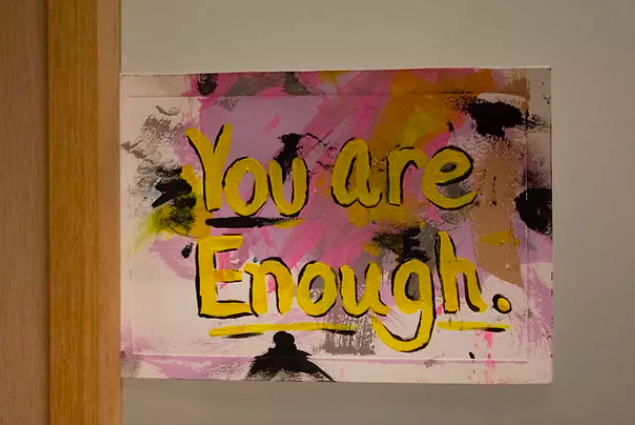For Domestic Violence Victims In Indiana, Help Starts With A Call
- By Lacey Watt, TheStatehouseFile.com
- Â

Photo by Lacey Watt, TheStatehouseFile.com.
 Life wasn’t easy​
Despite being heavily involved in high school activities such as cheerleading, having the lead role in school plays, and getting good grades, one victim’s home life was a different story.
Jane Doe’s family consisted of her father who was an alcoholic, older siblings that were manipulative and emotionally abusive, and a stay-at-home mother who made sure she was showered with love despite the drawbacks.
“My mother was the only true love I had in my life. I was lucky enough to have known her for the 17 years that I did before God had to take her home,†Doe said.
She was confused, broken, and constantly living in fear. After Doe’s mother lost her battle to breast cancer, she felt more alone than ever. It wasn’t too long before her father started dating a new woman and decided to sell her childhood home, leaving his daughter to fend for herself.
Doe found herself with friends more often, drinking heavily, smoking cannabis, and starting to date men who mirrored her father’s behavior.
After having children, she would constantly work out and go on crazy diets to maintain the trophy wife look, only to be screamed at, put down, and abandoned to raise her children on her own.
“I tried making it work the best I knew how to, by sitting still and looking pretty,†Doe said. “I thought if I was pretty and did what I was told to do that I would somehow make my fairytale of a happy family come true.â€
In order to support herself and her children, she took a job at a bar.
With some time passing after working shift after a shift at the bar, she had met a man that she thought could end the cycle of her madness. She had finally decided to quit working and become a full-time stay-at-home mother and housewife. That was until she had discovered his strong addiction to meth.
During this time, she had given birth to two baby boys, but the family had been homeless for five years because she said he chose his addiction over her and their children. She had finally had enough.
“My sobriety and his addiction were never going to mix. They weren’t supposed to mix,†she said.
After staying strong on her own for so long, she decided to end the vicious cycle and made the important call to Sheltering Wings, a shelter home for domestic violence victims.
A Place For New Beginnings
Sheltering Wings, located in Danville, Indiana, has been serving its community since 2002, and currently has 40 residents, almost evenly split between women and children.
There, residents are given the chance to escape their abusive relationships and build themselves back up with protective housing and programs for residents to engage.
Cassie Mecklenburg, executive director of Sheltering Wings, has been working with the shelter home for eight years and oversees the administrative team and direct services, team. This includes fundraising, community relations, strategic planning, and much more.
“When people hear what I do, they’ll ask me or make a comment about how difficult that must be and what a terrible reason it is that we need to have an organization like this,†Mecklenburg said. “And while that is all true, what I find so inspiring about what we do is the tremendous amount of hope and opportunity for change.â€
Some of these opportunities include embracing empowerment support groups, which consist of three stages, each one needing full completion before moving onto the next. The first is called Domestic Violence 101, a five-week class for residents in the shelter for less than 45 days. The second class is Self Love, an eight-week class; the final class is Boundaries, another eight-week class.
Outside of classes, residents have their own private room and bathroom to escape to if they want, while still having access to many rooms to make their stay as comfortable as possible.
During designated hours, they can go to the fully equipped kitchen and food pantry and cook their own meals. While the mothers are preparing meals, children can keep busy in a side room full of toys and games.
There are also two laundry rooms set on both sides of the shelter for quicker access to cleaning clothes, a computer lab for any internet-based needs, and a chapel to help residents practice their faith.
Children and teenagers have their own rooms to hang out in as well. The children’s room includes toys, games, and books for the little ones, while the teenagers have a couch and TV set up for games on the PlayStation, Xbox, and Wii.
All this help can start with what is called a crisis call. People in need can call the shelter’s crisis number, then come in and complete a crisis assessment, answering questions that would qualify them for housing. Once approved, they have 24 hours to fully move into the shelter.
The average stay at Sheltering Wings is about 60 to 90 days. While there technically isn’t a maximum for how long a resident may stay, an individual can get an extension every 30 days if proactively working toward new goals such as pursuing affordable housing or starting a new job.
Dec. 27 will be one year at Sheltering Wings for Doe. Since her stay, she has followed the programs, taken classes and therapy sessions, and even joined group meetings to discuss progress.
For Donita Roberts, events and admin coordinator for Sheltering Wings, getting to know the residents who stay longer has a great impact on her.
“Certain residents that stay longer, you get to know,†Roberts said. “It’s nice to get to know them and get to interact better. That’s what’s impactful and meaningful. It’s what keeps you going.â€
Knowing The NumbersÂ
According to the National Network to End Domestic Violence, more than one in three women have experienced rape, physical violence, and/or stalking by an intimate partner in their lifetime. Nationwide, an average of three women are killed by a current or former intimate partner every day.
One organization that works in multiple ways to prevent these numbers from increasing is the Indiana Coalition Against Domestic Violence.
There are seven barriers to domestic violence survivability according to ICADV website. Those barriers are crowded shelters, inability to pay bills or utilities, lack of education and job training, limited safety net supports, lack of housing, inaccessible legal assistance and lack of reliable transportation.
Laura Berry, executive director of ICADV for 27 years, has been involved and working with Indiana’s 92 counties to ensure programs and resources are available. This includes supporting programs providing education and training, quality assurance standards, technical assistance and legal services.
ICADV launched a campaign called The Stigma Reduction Campaign because survivors were wanting more awareness to the public about the impact and reducing the shame and judgment of being a survivor.
“Everything we do is trying to create safe, stable and nurturing environments from birth and on,†Berry said.
The Legal Side
According to WomensLaw.org, the laws that apply to victims of domestic violence and sexual assault victims come from state laws. This includes dealing with protective orders, divorce, custody, crimes, and more.
ICADV also heavily supports the legal aspect of domestic violence. By having a legal services program, it provides free services and representation for survivors of domestic violence, sexual assault, immigration, and human trafficking.
Kerry Hyatt Bennett, chief legal counsel of ICADV since 2005, helps guide approximately 65 centers with any legal questions as an individual business entity. For example, if someone from a shelter in Evansville has an emergency hearing coming up and has no access to legal counsel, they can be referred to Hyatt Bennett and she will then help find an attorney in that area.
“It’s scary going to court. It’s scary going to court representing yourself and it’s especially scary to go to court representing yourself against someone who has hurt you or threatened you,†Hyatt Bennett said. “So we sort of even out the playing field by making sure they have an attorney who is well-rehearsed in this area of law.â€
Understanding The SIgns
In order to prevent domestic violence, one main tactic is to recognize the signs.
From the National Domestic Violence Hotline’s website, the signs to recognize an abuser can include: the abuser telling you that you never do anything right, showing extreme jealousy of your friends or time spent away from them; preventing or discouraging you from spending time with friends, family members, or peers; insulting, demeaning, or shaming you, especially in front of other people; preventing you from making your own decisions, including about working or attending school, and a few more.
Just one or two of these behaviors can be a red flag that the relationship may be abusive and it is time to seek help.
NDVH also acknowledges that relationships, in the beginning, may seem perfect and that these behaviors may not always appear overnight. Every relationship is different and domestic violence may not always appear to be the same.
In any of the events or occurrences, someone experiencing domestic violence and needing immediate help can call the NDVH’s number, 1-800-799-SAFE or text START to 88788.
Doe acknowledged the red flags in her relationship and made the call that changed her life. She never gave up.
“I kept going no matter how bad things had been or no matter how many tears I’ve shed,” Doe said. “There is always a light at the end of the tunnel, you just have to let the light inside you.”





